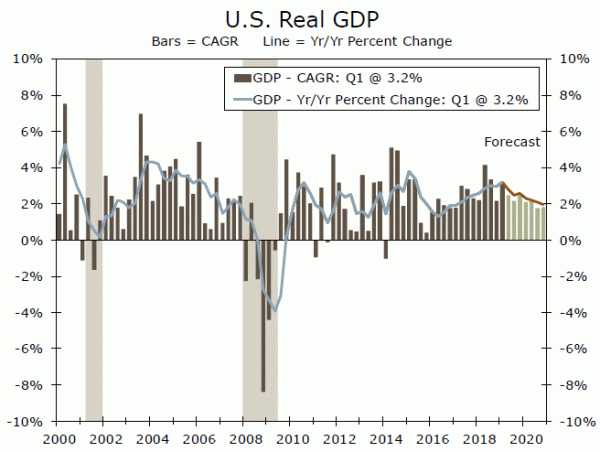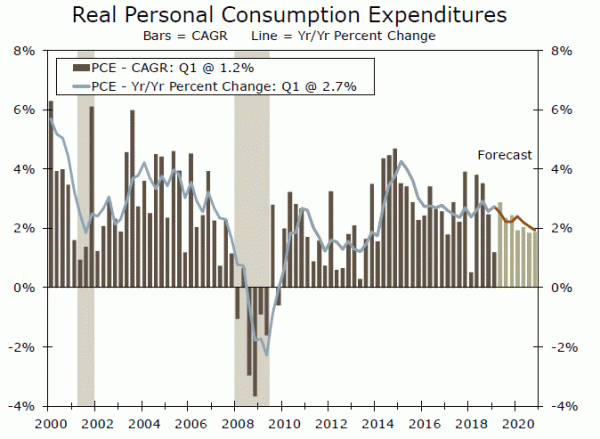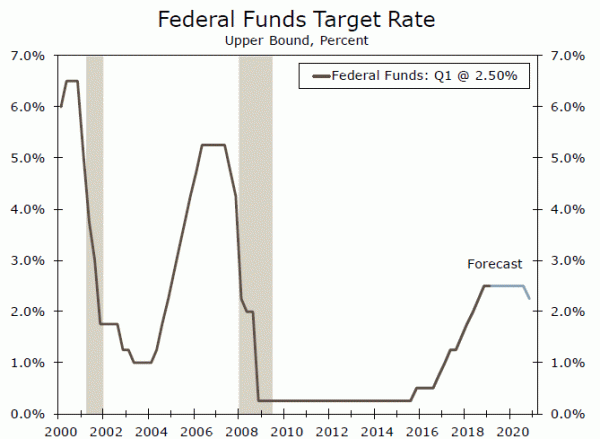We maintain the forecast that we released on May 8. However, we acknowledge that the recent escalation of the U.S.-China trade war skews the risks to our GDP forecast to the downside.
We Maintain Our Forecast, at Least for Now
President Trump has carried through on his threat to raise tariffs to 25% from 10% on $200 billion worth of Chinese imports, and the administration is drawing up plans to potentially levy tariffs on the $300 billion or so of Chinese imports that have not yet been subject to tariffs. In response, China has jacked up tariffs on $60 billion of American exports. What are the implications of these moves for our economic outlook?
In the forecast that we released on May 8, we projected that U.S. real GDP would grow 2.8% in 2019 and 2.1% next year. Because the United States and China may still eventually agree to a trade deal, which would lead authorities to rescind the tariffs, we have not made any formal changes to this forecast. However, we readily acknowledge that the risks to our GDP forecast are skewed to the downside. We estimate that higher tariffs on Chinese goods could lift consumer price inflation between 0.1 percentage point, if duties are confined to only $200 billion of Chinese imports, and 0.4 percentage point, if duties are placed on all Chinese goods. Everything else equal, higher inflation would reduce growth in real disposable income, which could erode growth in real personal consumption expenditures (PCE). The stock market has weakened recently because of trade tensions, and continued declines in equity prices would impart a negative wealth effect on real PCE as well.
In addition, business fixed investment spending, which we project will grow 3.9% this year and 3.5% next year, could also be negatively affected by the hit to American exports to China as well as to uncertainty related to U.S. trade policy. We maintain our view, which we have highlighted previously, that a trade war probably would not lead to a U.S. recession. But we also acknowledge a trade war would weigh on overall GDP growth.
We believe that the Federal Reserve would look through any near-term increase in inflation that resulted from higher tariffs. We currently forecast that the Fed will be on hold through most of next year. But we would be inclined to move forward our expectation for a rate cut, which we currently forecast for Q4-2020, if higher tariffs lead to slower GDP growth. The escalation of the trade war would lead to slower growth in China as well, although it would likely not bring the economy to its knees because Chinese authorities would respond with more accommodative economic policies. The Chinese renminbi, which has already weakened versus the U.S. dollar, would probably depreciate further.
It appears that President Trump will meet Chinese President Xi on the sidelines of the G-20 meeting in Japan on June 28-29. The two leaders could potentially agree on a deal, or at least a potential truce, at that meeting. However, if negotiations fall apart, we will need to make the changes to our current forecast that are discussed above. Stay tuned.
















